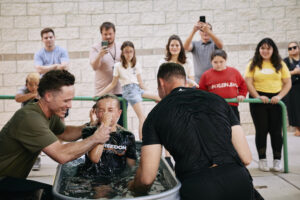
THOUSAND OAKS, Calif. (BP)–Anakin Skywalker, the future Darth Vader, last seen in “Episode One” as a 10-year-old boy, is now grown up. While an interstellar battle arises, Anakin accepts a mission as Jedi bodyguard to Princess-turned-Senator Amidala played by the now very grown-up Natalie Portman.
In 1977, creator George Lucas put a spin on the old-fashioned western, placing the action in outer space rather than Tombstone. Using spaceships that completely filled a Cinerama film screen, and a villain every kid in America wanted to defeat in battle, he made “Star Wars” the most popular good vs. evil franchise of all time. It grabbed our imaginations and took us for the intergalactic ride of our lives.
But along with laser sabers and hover cars, Lucas included the most important elements to any movie that wishes to live on in cinematic history: characters you care about and a compelling story. That was missing in “Stars Wars Episode One, The Phantom Menace.” Fortunately, this time out, Mr. Lucas has once again spotlighted both character and plot.
Also, I had hoped Lucas would resist the incessant use of gratuitous sex or profane language, common in most films of the ’90s. Gratefully, that element of Lucas’s storytelling ability remains consistent with the first four episodes. There is no sex. No misuse of God’s name. And no crudity.
Now for the bad news. As I said, there is story and character development (well, somewhat), but most anything the movie has to say is overshadowed by one space battle after another. The action plays out like a very expensive video game. Those looking for constant space battles that move like an arcade attraction will surely find this episode satisfying. Moviegoers looking for poignancy and depth may not.
Hayden Christensen plays Anakin Skywalker with a moody James Dean style, all pouty and paranoid, fighting that darker side. True, we are discovering how Anakin became the dastardly Darth Vader, but it was unnerving having this guy as the film’s hero. It’s difficult to like the main character, knowing he will become an evil being. It’s like feeling sympathy for the devil.
This new installment does have an incredible look. The screen is filled to capacity at all times with state-of-the-art visual effects, color and movement. Lucas has obviously been influenced by the great filmmakers, everyone from John Ford to Ridley Scott. Several scenes brought to mind classic moments from “The Searchers,” “The Sea Hawk,” “They Died With Their Boots On” and “Gladiator.” Either meant as an homage to these past filmmakers, or simply a downright steal of their vision, Lucas brings powerful images and statements to the screen that have been successfully used in films past.
Over the years, many theologians have written about the inclusion of Eastern philosophies and occultish themes in this film series. Personally, I find it difficult to take religious ideologies too seriously in a film with Muppet-like aliens as main characters. However, Marcia Montenegro, a former astrologer, now a born-again Christian with a ministry devoted to helping people avoid the trappings of the occult, is very cautious about the “Star Wars” phenomenon. As she puts it, “George Lucas, a student of Eastern religions, includes many Zen Buddhist and Taoist ideas in his ‘Star Wars’ movies, especially in his presentation of the Force [as] an example of light and dark dualism.”
What should be discussed by concerned parents is the conception of young Anakin Skywalker. At one point in “Phantom Menace,” his mother confesses that the boy was conceived without a father. This, of course, causes members of the Jedi counsel to wonder if the child is the Chosen One, the future savior of the galaxy. Some may feel that proclamation (not referred to in this episode) may trivialize the significance of the virgin birth of Christ and his entrance into human form. My suggestion: Parents, if you are allowing your younger children to attend, you should view this film with them. Make sure they understand the difference between the film’s “Force” and the real Force, Jesus Christ.
I don’t think “Star Wars” is going to lead a great many people into following Eastern religions. But it does subtly cultivate such philosophies. My suggestion, and I believe Marcia will back me up on this, is that if parents know the teachings of God’s Word, they can help their children spot and resist misleading beliefs in films. “Train a child in the way he should go, and when he is old he will not turn from it,” as Proverbs 22:6 puts it.
The movie was not rated at the time of a preview screening: The violence is cartoonish, with no blood; a mythological “Force” is a guiding light for the Jedi warriors, but the mysticism is played down, as the filmmakers put emphasis on battle action; we see Anakin giving in to the darker side when, out of vengeance, he kills an entire village he considers responsible for his mother’s death; and the death of a mother may trouble little ones.
To learn more about “Star Wars” and occultic influences on our society, check out Marcia Montenegro’s website at http://cana.userworld.com. Her offerings on the site are very informative, with a sound knowledge of God’s Word backing up her views.
–30–
Philip Boatwright reviews films from a Christian perspective. For more information about his service, go to www.moviereporter.com.















